|
Lens
|
SAL-135F18Z Sony 135mm F/1.8
|
|
Box contents
|
Front and rear caps, carrying pouch, hood and a users manual.
|
|
Cost
|
$1798 retail
|
|
Build quality
|
Very good
|
|
Additional information
|
New Carl Zeiss design for Sony.
|
| Specifications below |
|
|
Optical configuration
|
11 elements in 8 groups
|
|
Angle of view
|
18° full frame, 12° APS-C.
|
|
Aperture
|
9 blades, circular
|
|
Full frame and APS-C
|
Yes, made for full frame. APS-C equivalent, 202.5mm
|
|
Depth of field and focus scales?
|
Yes and yes
|
|
Minimum focus, image plane to subject
|
28.3″ (720mm)
|
|
Minimum focus, end of lens barrel to subject
|
21.5″ (546mm)
|
|
Hard stop at infinity focus?
|
No
|
|
Length changes when focusing?
|
No
|
|
Focus ring turns in AF?
|
No
|
|
Filter size
|
77mm
|
|
Filter ring rotates?
|
No
|
|
Distance encoder?
|
Yes
|
|
Max magnification
|
0.25x
|
|
Min. F/stop
|
F/22
|
|
Sony teleconverter compatible?
|
No
|
|
Dimensions W x L (my measurements)
|
3.46″ x 4.53″ 88mm x 115mm
|
|
Maximum extended length (my measurements)
|
4.53″ (115mm)
|
|
Weight bare (my scale)
|
35oz (992g) 36.3oz (1029g) with caps, hood=5.7oz (162g)
|
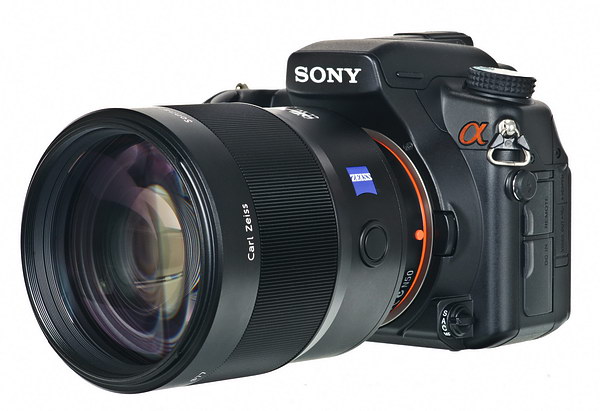 |
| Mounted on Sony A700. |
 |
| Box contents with no box |
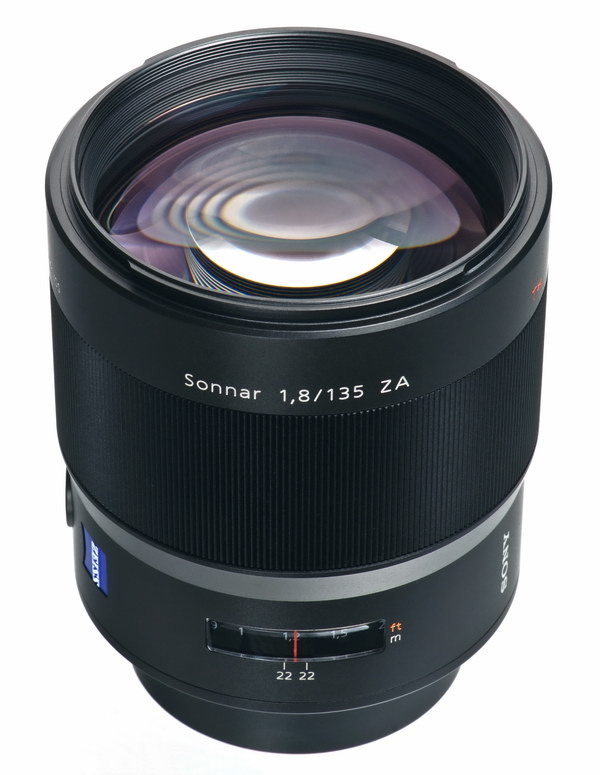 |
| Side shot |
 |
| Front element |
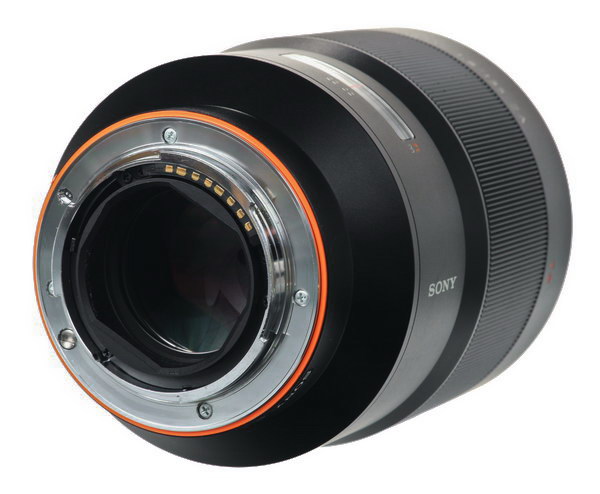 |
| Backside |
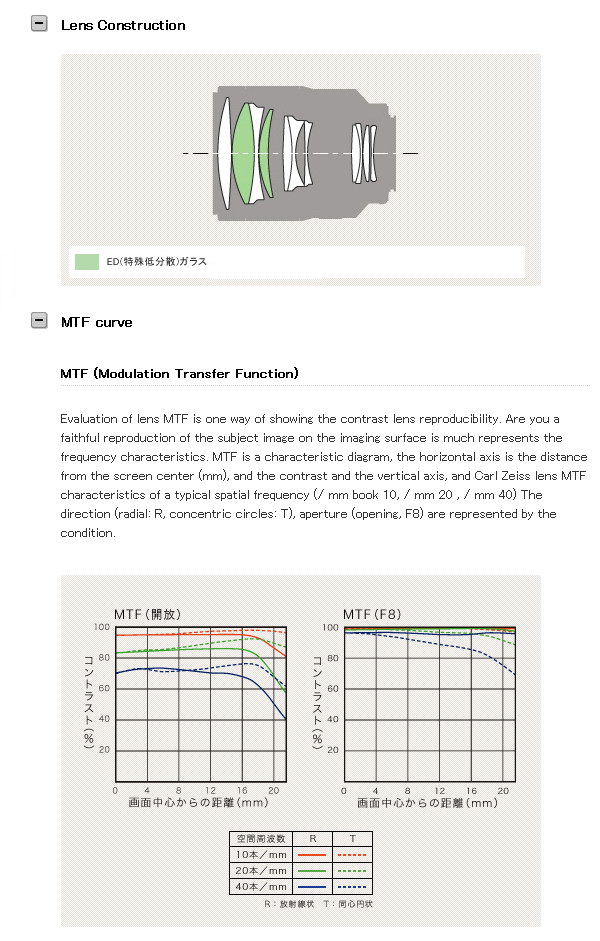 |
| Sony X-ray view and MTF chart |
The Sony 135mm F/1.8 Carl Zeiss sonnar (made in Japan) lens is fast, expensive, and very heavy for its size. It’s aimed at advanced amateurs and professional photographers who shoot primarily in available light, hand-held conditions. It would also make a good portrait lens which would help justify the cost. This is an all new Carl Zeiss design, and not a re-badged Minolta. Sony claims the use of two “ED” glass elements in the construction of the lens. Box contents also include a metal hood, and a black vinyl-type carrying pouch.
|
Veiling glare and ghosts, F/5.6
|
Pesky green blob, F/5.6
|
 |
 |
|
Bokeh, F/1.8
|
Bokeh, F/2.2
|
 |
 |
|
Bokeh, F/2.8
|
Bokeh, F/4
|
 |
 |
The top left shot shows some average veiling glare and ghosts, use the hood and try to keep the sun out of the image. The right shot shows the sun at an angle, with the camera held in the vertical position. You can pick out a bright green blob. With the sun centered, there isn’t much of a problem. Try to avoid images with the sun in the shot. If you block the sun with your hand or hood when it’s outside the image, there aren’t any problems like you see above. This lens is just barely average for controlling flare and ghosting.
The bottom crops show bokeh. Out of focus highlights look very smooth wide open, and retain an even, circular look near F/4. When out of focus highlights are in front of the subject, the bokeh isn’t so good.
Distortion below.
 |
| Very light pincushion distortion. |
Distortion is nearly non-existent. If you like examining your pictures with a grid overlay, you’ll see a very small amount of pincushion. This lens shows the minor pincushion distortion at all focusing distances, unlike the Sony 85mm F/1.4, which changes distortion (pincushion to barrel) as the focusing distance changes.
Light fall-off.
|
F/1.8
|
F/2.2
|
 |
 |
I wonder how sharp the corners are?
|
F/1.8
|
F/2.2
|
 |
 |
|
F/2.8
|
F/4
|
 |
 |
|
F/5.6
|
F/5.6, from center of image
|
 |
 |
These crops are from the extreme bottom right corner, and focused at infinity. Things look good here at F/1.8, and real good past F/2.8. In real shots, you’d be pleased as punch with the F/1.8 corners. F/5.6 seems to be the maximum sharp aperture in the corners, so there’s no need to stop down past that. I threw in a center crop at F/5.6 to show you the difference between that shot and the F/5.6 corner shot. I see no difference between the two crops. Also note the nearly imperceptible lateral color fringing, which is far less than what shows up on the Sony 85mm F/1.4 CZ.
How sharp are the centers if the images are enlarged to a staggering size?
|
F/1.8
|
F/2.2
|
 |
 |
|
F/2.8
|
F/4
|
 |
 |
|
F/5.6
|
F/8
|
 |
 |
|
F/11
|
F/16
|
 |
 |
|
Full frame results using the Sony A900 below. Check out the differences when using a film or full frame camera below. I’m only pointing out the noticeable issues as compared to the APS-C bodies, so if I don’t show it here, the results are not significantly different enough to warrant posting an additional set of images in this section.
Light fall-off
Light fall-off on a full frame camera is a little more noticeable as opposed to the APS-C crops shown earlier, but only at F/1.8, where it looks moderate. It’s mild at F/2.2, then nothing by F/2.8
Full image from A900 below. 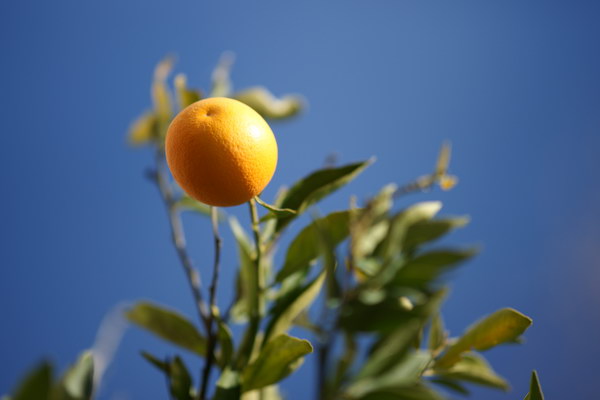
The moderately dark corners are noticeable here, but it doesn’t detract from the pretty orange, which is nearly overhead. This shot was taken at F/1.8, 1/5000sec ISO 100!! As always, don’t shoot normal daylight scenes at F/1.8 unless you’re looking for a super slim DOF.
Corner samples next.
The corner performance is similar to the APS-C crops, which is good. There isn’t much difference in sharpness as you stop down, and they look nearly the same, except for light fall-off at F/1.8-2.2. In the last row I show the difference between the corner shot at F/5.6, and the center shot at F/5.6. I see virtually no difference as compared to the centers, super good full frame performance. I see a very small amount of color fringing along the wall towards the bottom of the cropped image at F/4-5.6. It doesn’t show at larger apertures because of the darker corners. These crops come from the extreme lower right corner. Focused at infinity.
Distortion.
The distortion amount on a full frame system is about the same as the APS-C shot, showing a small amount of pincushion distortion. Coma results with full frame The Sony 135mm lens has no coma, even at F/1.8. Comparison crops between the Sony CZ 135mm F/1.8 lens and the Sony 70-200mm F/2.8 G below.
The Sony CZ 135mm does a great job (as expected) when directly compared to the Sony 70-200mm G zoom, set at 135mm. The top row shows the 135mm at F/1.8, and it looks about the same as the zoom does at F/2.8. The second row shows both lenses at F/2.8, and the 135mm is slightly sharper. The bottom row shows the two at F/5.6, and at this point, they look about the same, which is no surprise. All shots focused at infinity.
|
















